The Philippines is home to around 1,000 butterfly species, with approximately 40% found only in the archipelago. These species belong to diverse families, including Nymphalidae, Lycaenidae, and Papilionidae, each characterized by unique colors and patterns.
The Magellan Birdwing and the Common Windmill are notable examples of this rich diversity.
Butterfly populations serve as indicators of ecosystem health. Therefore, their conservation is crucial in the face of threats like habitat loss and climate change.
The Philippines' varied habitats, ranging from urban environments to remote islands, support this biodiversity. Understanding the importance of these habitats can enhance our appreciation of butterflies and their ecological roles.
Overview of Philippine Butterflies
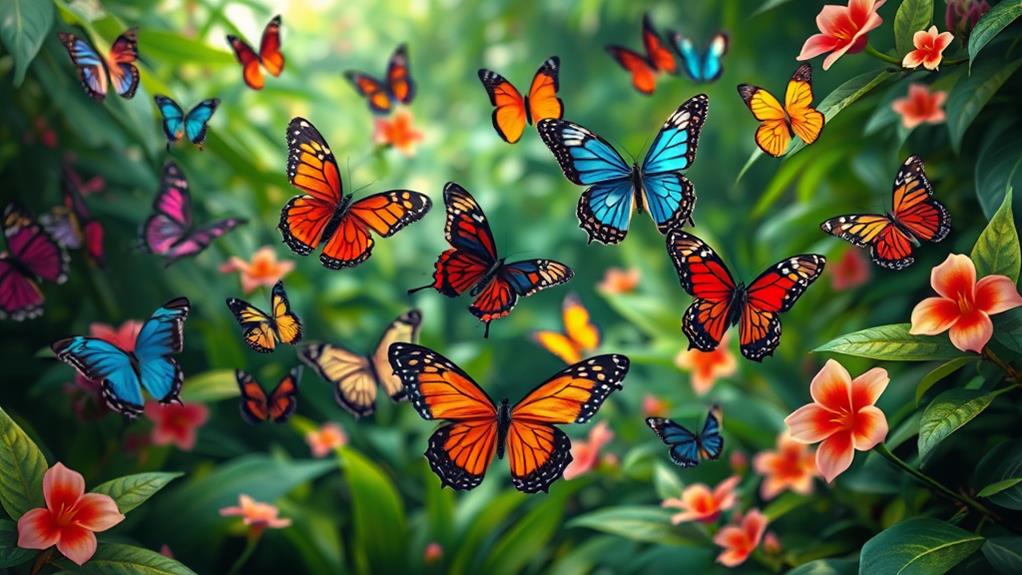
The Philippines is home to a diverse array of butterfly species, with approximately 40% of its 1,000 species found nowhere else on Earth. This high level of endemism is attributed to the country's unique geography, comprising diverse islands that support a wide range of ecosystems.
Five major butterfly families are represented in the Philippines: Nymphalidae, Lycaenidae, Papilionidae, Hesperiidae, and Pieridae. Each family has distinct physical and ecological characteristics that enable them to adapt to the country's varied environments.
The Magellan Birdwing is a notable species in the Philippines, distinguished by its large size and ecological importance. As pollinators and indicators of environmental health, these butterflies play a crucial role in maintaining ecosystem balance.
The conservation of butterflies in the Philippines is essential, as they reflect the region's broader biodiversity. However, these species face significant threats from habitat loss, climate change, and pollution.
Effective conservation strategies must prioritize habitat preservation and restoration to ensure the survival and thriving of these unique butterfly populations in their native ecosystems.
Unique Butterfly Species
The Philippines is home to a diverse range of butterfly species, with approximately 1,000 species found across the archipelago, 352 of which are endemic.
This remarkable biodiversity is crucial to the ecosystem, with each unique species playing a vital role.
One notable example of this biodiversity is the Magellan Birdwing, one of the largest butterflies globally, with a wingspan of up to 19 centimeters.
It's primarily found in Palawan and Mindanao.
The Common Windmill (Papilio Karna) is another notable species, characterized by its large size and distinctive black and white wing patterns.
It can be found in various habitats throughout the Philippines.
The Atrophaneura Semperi (Sempers Birdwing) features striking black and red wing markings, making it a significant pollinator within the forests of Mindanao and Samar.
The Common Crow (Euploea Core) is a medium-sized butterfly with dark brown wings marked by white spots.
It is known for its strong flying abilities and crucial contribution to pollination.
These unique butterfly species exemplify the Philippines' rich biodiversity and ecological significance. The Troides magellanus, also known as the Magellan birdwing, is a stunning butterfly species found in the Philippines. Its large wingspan and vibrant colors make it a sight to behold in the lush forests of the country. Another remarkable species is the Parantica libythea, or striped tiger butterfly, which can be found in the Philippines’ tropical habitats. These butterflies not only contribute to the beauty of the ecosystem but also play a crucial role in pollination and the overall health of the environment. Furthermore, the Philippines is also home to a variety of carnivorous plants in Philippines, which further demonstrates the diverse and unique nature of its flora and fauna.
Habitats Supporting Diversity
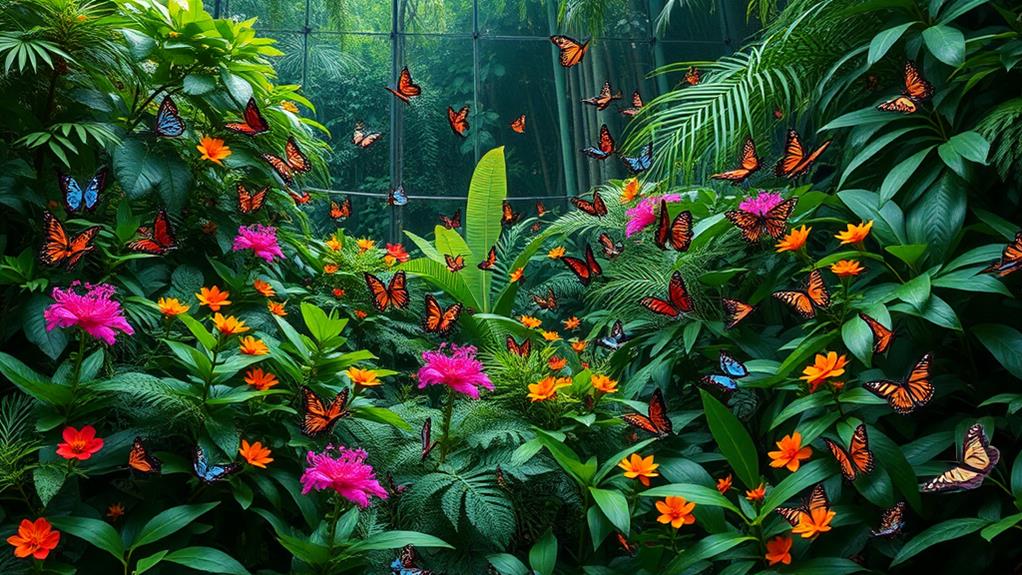
The Philippines' diverse habitats support a wide range of butterfly populations. The country's tropical forests, gardens, and fields provide a home for approximately 1,000 butterfly species, with 352 found only in the Philippines.
Tropical forests are critical habitats for larger butterfly species. For example, Palawan and Mindanao are essential habitats for the Troides magellanus (Magellan Birdwing), which thrives in these environments.
Even urban areas can support butterfly populations. The Cultural Center of the Philippines (CCP) in Pasay City is home to 11 butterfly species, demonstrating that well-maintained gardens and green spaces can nurture these insects.
Catanduanes Island has the highest recorded butterfly diversity in the Philippines. The island is home to 134 butterfly species, highlighting the importance of preserving various habitats to maintain biodiversity among butterflies.
Ecological variety is essential for supporting butterfly populations. The adaptability of species like Papilio karna (Common Windmill) demonstrates the importance of diverse habitats.
By preserving diverse habitats, you can help ensure the survival and proliferation of butterflies in the Philippines, contributing to the overall health of these ecosystems. Each habitat type plays a vital role in sustaining the intricate web of life that includes these remarkable insects.
Butterfly Families in the Philippines
The Philippines is home to numerous butterfly families that contribute to the country's rich biodiversity.
Each family has unique characteristics and adaptations.
The Nymphalidae family is known for its diverse patterns and sizes, with butterflies often displaying vibrant colors and unique wing shapes.
The Lycaenidae family is famous for its striking colors, with butterflies frequently featuring false heads with eyespots, a clever adaptation against predators.
The Papilionidae family includes the iconic Magellan Birdwing, recognized for its tailed wings and larvae that possess a foul taste, deterring potential threats.
The Hesperiidae family is characterized by small butterflies with a darting flight and hooked antennae, making them stand out among their counterparts.
The Pieridae family showcases butterflies predominantly in white, yellow, or orange hues, with larvae feeding on cruciferous plants, solidifying their ecological roles.
Each family enriches the Philippine ecosystem, making it a vital area for butterfly conservation.
Ecological Importance of Butterflies

Butterflies are crucial pollinators in the Philippines' ecosystem. They facilitate the reproduction of flowering plants, maintaining ecosystem health and supporting the region's rich biodiversity.
With approximately 1,000 identified species, their diverse presence indicates a balanced ecological system.
Butterflies are sensitive indicators of environmental changes. Changes in their populations can reveal broader ecological issues, making them vital for monitoring ecosystem stability.
For example, the Magellan Birdwing and Common Mormon species illustrate the essential roles butterflies play in plant-pollinator interactions. These interactions are crucial for the survival of many native plant species, ensuring the integrity of the ecosystems they inhabit.
The decline of butterfly populations poses significant threats. Habitat loss, pollution, and climate change are major contributors to this decline, which not only endangers butterflies but also jeopardizes the overall biodiversity and functionality of their ecosystems.
Recognizing the ecological importance of butterflies is crucial for appreciating the intricate connections that sustain the Philippines' natural environment.
Conservation Challenges
Conservation Challenges Facing Butterfly Populations in the Philippines
Butterfly populations in the Philippines are facing critical and multifaceted conservation challenges. These challenges stem from various factors, each contributing to the decline of butterfly species. The primary threats are:
Habitat Loss: The destruction of essential environments due to deforestation and urbanization is displacing butterfly populations. For example, the clearing of forests for agriculture and urban development has led to the loss of habitats for species like the Philippine swallowtail.
Climate Change: Altered temperature and rainfall patterns are disrupting breeding cycles and migration routes, putting additional stress on these delicate species.
Rising temperatures are altering the timing of butterfly migrations, causing them to arrive at habitats that are no longer suitable.
Pollution: Agricultural pesticides and urban waste are contaminating food sources and breeding habitats, adversely affecting butterfly health and reproductive success.
The use of pesticides in rice fields has been linked to the decline of the common millet skipper**.
Invasive Species: The introduction of non-native species is creating competition and predation pressures, further threatening native butterflies and disrupting local ecosystems.
The introduction of the cane toad has led to the decline of several butterfly species that rely on the same food sources.
Addressing these challenges is crucial for the survival of the Philippines' rich butterfly diversity. Effective conservation programs and increased public awareness are necessary to prevent the extinction of unique butterfly species.
Advocating for sustainable practices and habitat protection can ensure these beautiful insects continue to thrive in their natural environments.
Butterfly Monitoring and Research
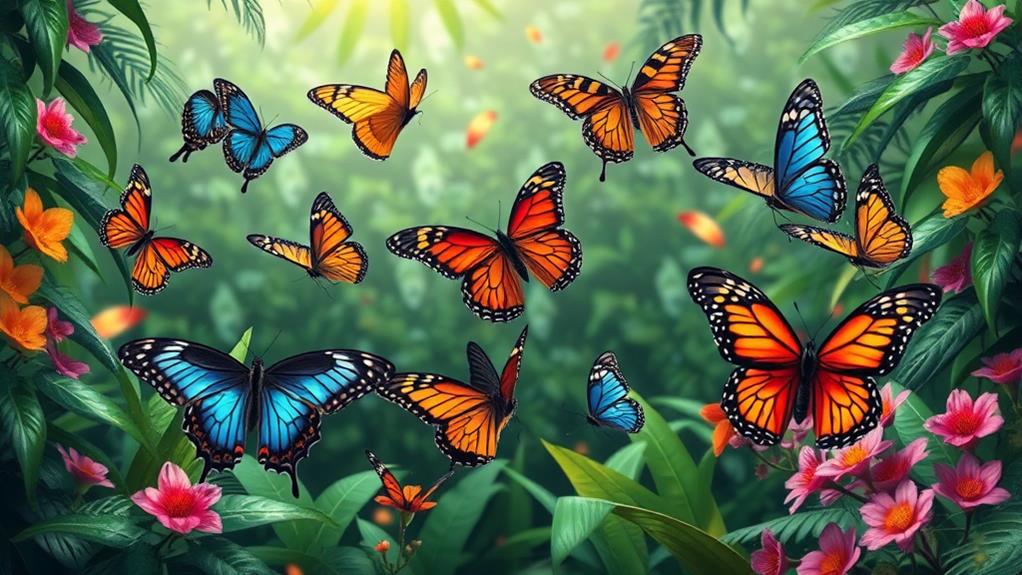
Butterfly monitoring and research in the Philippines are crucial for understanding their dynamics and ensuring their survival. The country is home to a rich diversity of butterfly species, with 352 species identified as endemic.
Taxonomic studies are ongoing to catalog this diversity. Organizations like the Philippine Lepidoptera Butterflies and Moths Inc. (PhiLep) are conducting research on new taxa, species diversity, and population dynamics across various habitats, providing critical insights into butterfly monitoring.
Citizen science projects play a vital role in butterfly monitoring. By encouraging public participation, these projects enable enthusiasts to contribute valuable data on butterfly populations and distributions.
For example, a recent study on Catanduanes Island documented 134 butterfly species, highlighting its significance as a conservation site.
Digital platforms enhance butterfly monitoring efforts. They facilitate data sharing and species identification, fostering collaboration among researchers and conservation groups.
These tools enable individuals to actively engage in butterfly monitoring, contributing to a broader understanding of ecological patterns and trends.
Your involvement can significantly influence conservation strategies. By participating in butterfly monitoring, you can promote the survival of diverse butterfly species in the Philippines.
Cultural Significance of Butterflies
In Filipino culture, butterflies represent transformation and the delicate nature of life itself, going beyond their natural beauty. These creatures hold significant cultural importance, manifesting in various aspects of Filipino life and traditions.
Folklore and Symbolism: Butterflies symbolize transformation and the fragility of life, reflecting the journey from caterpillar to butterfly as a metaphor for personal growth. For instance, the transformation of a caterpillar into a beautiful butterfly mirrors the struggles and challenges humans face in their own lives.
Art and Craft: Local artisans incorporate butterflies into crafts and artworks, showcasing the rich biodiversity and artistic expression of Filipino culture. These intricate designs often feature colorful butterflies amidst tropical flowers and leaves, highlighting the country's vibrant natural heritage.
Festivals: The Marinduque Butterfly Festival is a prime example of how butterflies bring communities together, celebrating biodiversity and promoting ecotourism. During this event, locals and tourists alike come together to marvel at the beautiful butterflies, participate in traditional dances, and learn about the importance of conservation.
Education and Awareness: Educational programs featuring butterflies raise awareness about biodiversity, linking cultural identity with ecological stewardship in the Philippines. By teaching children about the life cycle of butterflies and their role in the ecosystem, these programs inspire a sense of responsibility towards the environment and its precious creatures.
Through these elements, butterflies serve as a vital bridge between ecological awareness and cultural expression, enriching local heritage.
Popular Butterfly Watching Locations
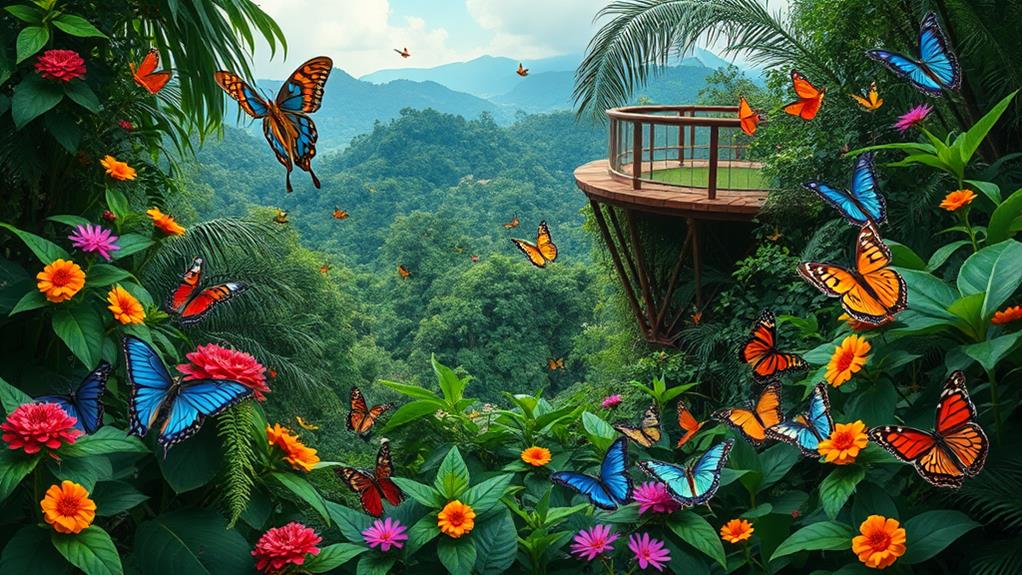
The Philippines is a prime destination for butterfly enthusiasts due to its rich biodiversity and ecological significance.
Marinduque, the "butterfly capital of the world," is home to an impressive variety of species, offering enthusiasts and researchers the opportunity to observe the largest butterflies in their natural habitats.
Catanduanes Island stands out for its high butterfly diversity, boasting 134 species that underscore its ecological importance.
The forests of Mindanao and Samar are home to captivating species like Atrophaneura semperi and Troides magellanus, known for their striking appearances, which draw avid watchers.
Baguio City's cooler climate supports unique species, such as the Golden-Tailed Hairstreak, enhancing its status as a prime butterfly watching locale.
Even urban areas like the Cultural Center of the Philippines (CCP) in Pasay City reveal diverse populations, with 11 species documented, proving that butterflies can thrive even in city environments.
Endemic Butterfly Species
The Philippines is home to approximately 352 butterfly species that can be found nowhere else in the world, making it a hub of unique biodiversity. This is largely due to the country's diverse ecosystems, which have led to the development of specialized adaptations in these endemic species.
One notable example of these endemic species is the Magellan Birdwing, which is one of the largest butterflies globally. Another example is the Scarlet Mormon, celebrated for its vibrant colors. These species not only showcase the aesthetic appeal of endemic butterflies but also highlight the importance of preserving their habitats.
Catanduanes Island stands out for its exceptional biodiversity, with a recorded 134 endemic species. This underscores the island's ecological importance and the need for conservation efforts.
Conservation Efforts are crucial to protect these endemic butterfly species, as many face threats due to habitat loss and climate change.
Preserving their habitats is essential for maintaining ecological balance and ensuring the long-term survival of these unique species.
Threats to Butterfly Populations
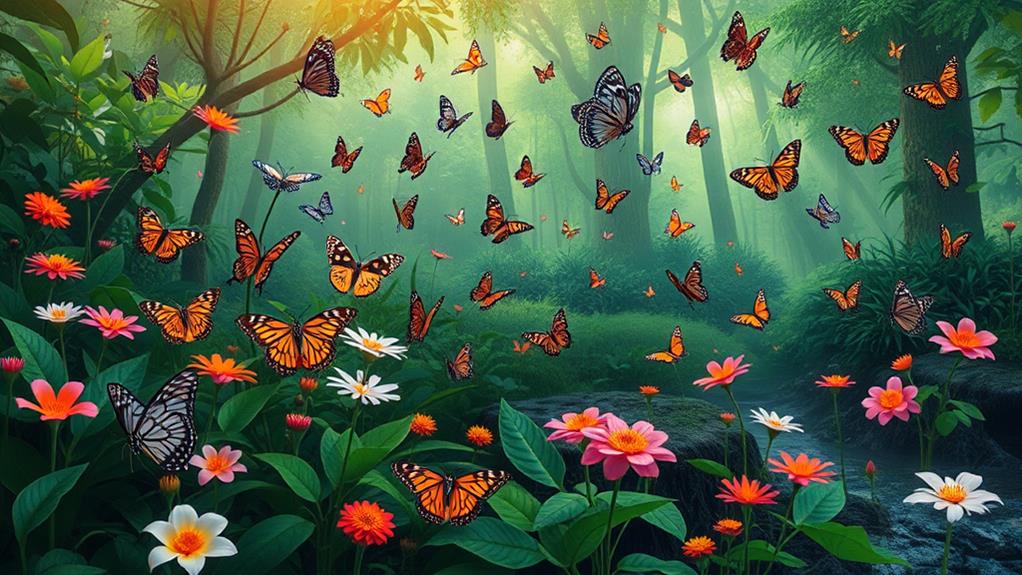
Threats to Butterfly Populations in the Philippines
Butterfly populations in the Philippines face multiple threats that significantly imperil their survival. Habitat loss is a major concern, as deforestation and urbanization disrupt their natural habitats and food sources. This is particularly problematic for the Lycaenidae family, commonly known as blues, which rely on specific plant species for survival.
Climate change also poses a significant threat, as it alters migration patterns and breeding cycles, leading to potential declines in species distribution. The Papilio family, which includes swallowtails, is particularly vulnerable to these changes, as they've specific temperature and humidity requirements for their life cycles.
Pollution is another key threat, as agricultural runoff and urban waste contaminate critical food sources and breeding sites essential for butterfly survival. The Nymphalidae family, commonly known as brushfoots, is heavily impacted by pollution, as they rely on specific plants for food and shelter.
Invasive species also threaten butterfly populations, as they compete for resources and habitat. The Danaidae family, which includes milkweed butterflies, is particularly susceptible to competition from invasive species, which can outcompete them for food and habitat.
These combined threats create a precarious situation for many butterfly species in the Philippines.
Conservation programs are urgently needed to address these challenges and protect the rich butterfly diversity found in the country. Without immediate action, we risk losing these vibrant species forever.
Engaging With Butterfly Conservation
Engaging communities in butterfly conservation is crucial for safeguarding the Philippines' rich biodiversity.
Local initiatives can significantly impact the preservation of endemic species like the Magellan Birdwing and Sempers Birdwing, which aren't just beautiful but also essential pollinators, playing a vital role in local ecosystems.
Educating others about butterflies as indicators of environmental health and the urgent need for habitat preservation is key. This can be achieved by participating in awareness campaigns, which highlight the importance of butterflies in maintaining ecosystem balance.
Encouraging community efforts to create butterfly-friendly environments helps maintain biodiversity. This can be done by supporting sustainable practices, such as planting nectar-rich flowers and reducing pesticide use, which provide a habitat for butterflies to thrive.
Collaborating with researchers to monitor butterfly populations provides critical data that informs conservation strategies. Engaging in research initiatives helps identify areas of high conservation value and informs policies that protect butterfly habitats.
Advocating for ecotourism in butterfly capitals like Marinduque generates funds for habitat protection and fosters appreciation for butterfly diversity. By promoting responsible tourism, local communities can benefit economically while protecting their natural resources.
Questions and Answers
How Many Butterfly Species Are There in the Philippines?
The Philippines is home to approximately 1,000 identified butterfly species. These species are distributed across the archipelago, with a significant number found on Catanduanes Island, which has 134 species.
Around 352 species are endemic to the Philippines, meaning they can only be found in this region. This unique characteristic highlights their important ecological roles.
The diversity of butterflies in the Philippines can be attributed to the presence of major butterfly families, such as Nymphalidae, Lycaenidae, and Papilionidae, each contributing to the rich biodiversity and playing a crucial role in the island's ecological dynamics.
What Do the Philippines Believe About Butterflies?
Butterflies Represent Transformation and Beauty in the Philippines
In the Philippines, butterflies embody cultural symbolism, representing transformation and beauty. This symbolism is reflected in local folklore, where butterflies are often portrayed as messengers signifying good luck or connections with departed loved ones.
For instance, in some Filipino myths, butterflies are believed to carry the souls of the dead to the afterlife.
Butterflies Unite Communities and Promote Conservation
Festivals celebrating butterflies reinforce community identity and engagement, showcasing the importance of these insects in Filipino culture.
Moreover, artistic expressions, such as traditional dances and crafts, highlight the aesthetic value of butterflies.
Educational programs also play a crucial role, stressing the ecological importance of butterflies and promoting awareness about biodiversity and conservation.
What Is the Insect Diversity in the Philippines?
Insect diversity in the Philippines is remarkable, with a high level of insect endemism.
Around 40% of species are unique to the region, resulting in a vast array of insects across various habitats like forests and gardens.
This rich biodiversity includes numerous families beyond just butterflies, such as beetles, ants, and bees.
Understanding this diversity is crucial for conservation efforts, as it helps appreciate the ecological significance and intricate relationships among species in the archipelago's ecosystems.
Which Country Has the Largest Diversity of Butterflies?
Colombia has the largest diversity of butterflies, with over 3,500 recorded species.
This is due to its diverse ecosystems and favorable climate.
The country's unique geography, which spans the Amazon rainforest, Andes mountains, and tropical coastlines, creates a variety of habitats that support a wide range of butterfly species.